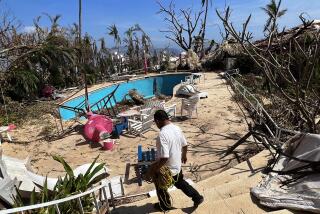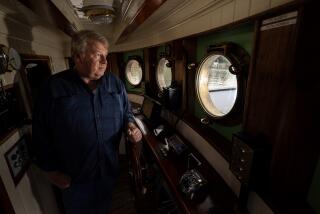Cyclone Stirs Up Adventure on Family’s Ocean Voyage
LA CANADA FLINTRIDGE — When Municipal Court Commissioner Kirk Nyby and his family set sail for the South Pacific 15 months ago, they hoped for high-seas adventure and lasting memories.
The La Canada residents got more than they bargained for on both counts.
For three harrowing days in March, about 500 miles off the Tonga Islands, the Nybys were chased by Cyclone Gene--a storm similar to a hurricane but smaller. Waves up to 22 feet high crashed over the deck of their 58-foot schooner and 70-m.p.h. winds battered their sails.
“We got a little more adventure than we wanted,” said Nyby, who presided over Division 2 of the Santa Anita Municipal Court in Monrovia for a dozen years before quitting to go on the cruise.
During their journey, the Nyby family--Kirk, 47, his wife, Ines, 42, and their children Pascale, 14, Tristan, 11, and Justine, 8--covered 15,000 miles sailing through such exotic ports as the Marquesas Islands, French Polynesia and Tahiti, Nyby said.
From June 2, 1991, to Aug. 10 of this year, their home was their home-built yacht, Pilot. Nyby and his wife had sailed the world by catamaran for three years in the early 1970s and hoped to repeat that kind of serendipitous, enriching experience with their children.
During most of the trip, the winds were too calm, Nyby said. In fact, the family began to stock extra diesel fuel to keep the boat moving when the trade winds died down.
But when they set sail for Tahiti from Tonga in March, believing that the hurricane season was over, they had been out to sea four days when they heard a radio report pinpointing Cyclone Gene 70 miles north of their boat.
With the storm at their backs, the Nybys turned the boat around and headed back to Tonga, moving away from the storm at an angle and trying to outrun it.
“The waves were running between 18 to 22 feet and breaking over our decks,” Nyby said. As the winds kicked up, the boat’s sails were damaged by the constant battering.
For three days, the Nyby children stayed below deck, sleeping on the floor of their cabin so they would not be pitched out of bed, Nyby said.
Kirk and Ines stayed at the helm, trying desperately to keep the boat upright and out of the storm’s way. “My wife and I got only a few hours’ sleep over three days,” Nyby said. “We were pushing the envelope there a little bit.”
They were relieved, to say the least, when they sighted Tonga. “Everyone (in the port) was very glad to see us. Another yacht that went out during hurricane season was lost at sea,” he said.
The children weathered the storm like the old deckhands they are, Nyby said, having sailed most of their lives. “(My wife and I) were more shook up than they were,” he said.
In contrast to their battle with the cyclone, the rest of their journey was marked by some tedium, especially the long days at sea when the winds were slow and the fishing only marginal.
“It was more boring than anything,” Nyby said. “We did not get a good average speed for our boat. We had a Gameboy with us and two of the kids became experts during our ocean passages. A lot of books were read. The kids watched I don’t know how many movies on the VCR.”
Armed with lesson plans from the children’s teachers, Kirk and Ines convened school every day from 8 to 11:30 a.m. Lessons were given Mondays through Fridays, with all holidays observed, including birthdays, Nyby said.
The children were required to keep journals of their experiences and each month they sent reports back to their classrooms. Every few months, the family made a videotape of their travels to send back to classmates, family and friends.
They met sailors from all over the globe and made lasting friendships with some of them, as well as with some of the Tahitians and Tongans they met while in port.
They also got accustomed to living closely with marine life--gray, humpback and sperm whales, porpoises, flying fish and turtles.
After school was over, the family took afternoons off--boating to small islands where they hiked on trails first cut by U.S. soldiers during World War II, skin-diving, picnicking on pristine beaches and exploring underwater caves.
“All the kids became real good free divers,” Nyby said. “The little one was able to dive about 25 feet down, and the older ones went about 40 feet.”
The last leg of the trip was spent in Oahu, where they anchored at the Hawaii Yacht Club and where Tristan learned to surf and Justine and Pascale learned boogie boarding.
“It seemed like the last opportunity we would have to spend an extended time together as a family before our eldest daughter got caught up in high school and then college,” Nyby said.
The family was jubilant when they reached Long Beach harbor during the early morning hours of Aug. 10. “There weren’t any fireboats out there squirting water or anything, but the harbor master came out and escorted us,” Nyby said. The Pilot slid into the same slip it had occupied for the two years before the journey.
Despite the cyclone, the trip was a positive experience for the family, Nyby said. “The kids learned a lot they would only learn by completely changing their environment. I think the trip will become more important, especially for them, as the years go by.”
Meanwhile, the children are back in school and seem to be adjusting well to everyday life, Nyby said. He is working as a roving court commissioner and his wife is polishing the journal she wrote while on the trip, hoping to find a publisher.
There is no more South Seas cruising in the Nybys’ plans.
“Those long days out at sea are tough,” Nyby said. “We’re not too inclined to do ocean cruises anymore. But the Mexican coast is nice and we heard great things about the Alaska inland waterway. . . . “
More to Read
Sign up for The Wild
We’ll help you find the best places to hike, bike and run, as well as the perfect silent spots for meditation and yoga.
You may occasionally receive promotional content from the Los Angeles Times.






